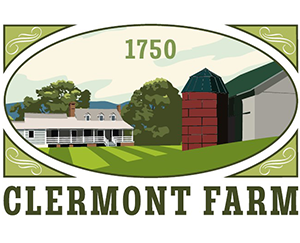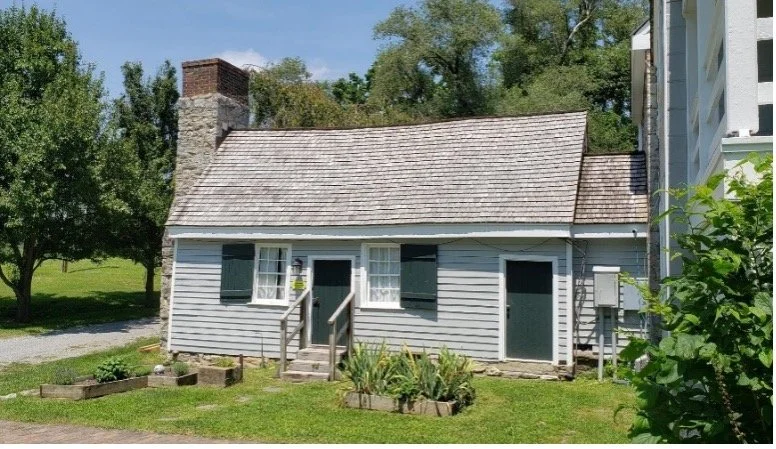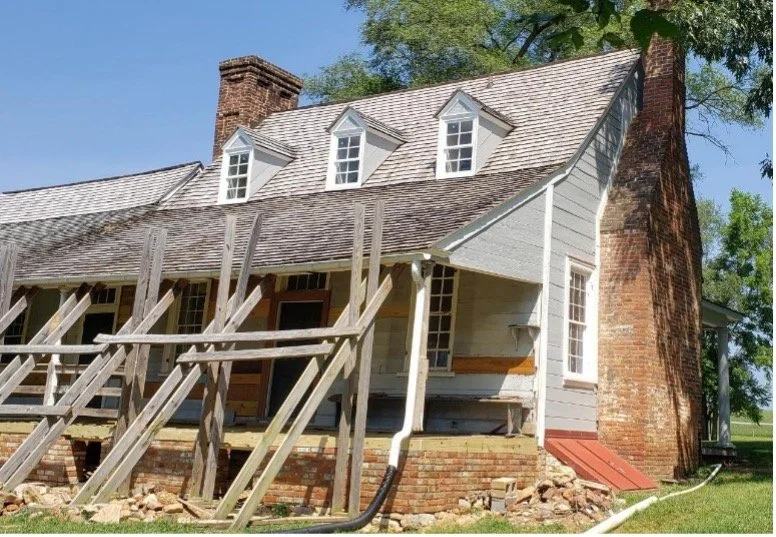Edward Snickers
(by 1728 – 1790)
Businessman, Supplier to the Revolution, Friend to its Virginia Leaders
When Edward Snickers bought Clermont from Thomas Wadlington in 1770, his accumulation of businesses, properties, and wealth had raised him from simple “yeoman” status (independent farmer) to that of a “gentleman”, a semi-official title in class-conscious Virginia, appointed as a member of the vestry of Frederick Parish in 1771 and by the Virginia General Assembly as one of the “ten gentlemen” responsible for maintenance of the great roads from Vestal’s and Williams’ Gaps to Alexandria and Colchester, and levying the taxes on property owners along the routes to do so.
Clermont kitchen, built by Edward Snickers in 1777, 65 feet west of the 1755 house. This kitchen served the owners from 1777 to 1971. Additions to the west of the 1755 house eventually reached this kitchen, allowing an internal connection.
Edward Snickers first appears in Frederick County, Virginia, records in 1749, maybe 21-25 years old, administering two estates (one his father’s), for which he had to post a bond of 700 pounds, very large for a young man of yeoman status. However, two important men in the community stood as sureties for his bond, so he and it were accepted. His father’s estate inventory held one clue to Edward’s later success, a” parcel of old books, 10 shillings”. Henry was literate, and so was Edward.
The start to all this was working as a farmer, horse trader, and teamster, hauling grain and flour to the international port at Alexandria. Then came the state license to operate what had been Williams’ Ferry over the Shenandoah River below Williams’ Gap in the Blue Ridge (now Snicker’s Gap, Rt. 7), no later than 1760, when a traveler mentions stopping there at the ferry and tavern, about 4.5 miles from Clermont and fifteen from Winchester.
During the French & Indian War (1754-63), as a local purveyor and expert, he helped procure horses and wagons, both for the British forces and Col. Washington, who used Snickers’ horses and wagons to ferry supplies for his Virginia Regiment from Alexandria to Winchester, where he was constructing Fort Loudoun in 1756-58. Snickers was a “Washington man”, having voted for him publicly in Winchester in 1758 when Washington was elected to his first political office in the Virginia House of Burgesses.
South porch, original ca. 1770, in rehabilitation under a NPS Semiquincentennial grant
George Washington made the first of many mentions of Edward Snickers in his diary on August 1, 1769, when he stopped at the ferry and tavern with Martha and her daughter, Martha Parke Custis, whom they were taking to the health waters at Berkeley Springs, WV. On the return on September 11, Washington also availed himself of the blacksmith shop Snickers ran at the ferry, as well as the food and drink.
Beyond the diaries are Washington’s letters, which show his trust in Snickers’ judgement of other men, as Ingrid Jones remarks in her monograph (1974) on Snickers, letters that indicate “Washington considered Snickers an honest, skillful practitioner, a man who knew how to get things done, especially things that required sophisticated handling.” Snickers assisted Washington with many land and crop deals and transported wheat (and millstones) to Washington’s new mill at Mount Vernon, and at his request, chose the tenants for land Washington had purchased in Frederick County. As money came in, Snickers began the land speculation which made his fortune, working sometimes with Washington, such as on the sale of the large George Mercer tracts on the Shenandoah. Near Clermont
During the Revolution, Snickers was a member of the Frederick County Committee of Safety. With a partner, the Rev. Charles Mynn Thruston (minister of Frederick Parish and later the ‘Fighting Parson’ under Washington), Snickers was appointed a Commissary and Paymaster for Virginia’s Revolutionary troops, especially those under Capt. John Neville at Pittsburgh and on the Ohio frontier, and those under Daniel Morgan, both men from Frederick County. A major testimony to Washington’s confidence in Snickers was his letter from headquarters at Trenton, NJ, of January 19, 1777, asking Snickers to serve as Wagonmaster General of the Continental Army, an offer he declined due to age. However, he did help the Army buy horses and wagons, sorely needed at this time.
Elizabeth Taliaferro and Edward Snickers married about 1755. They had four children, Sarah (1756), Catherine (1757), William (1759), and Elizabeth (1761). William served in the Revolution under Gen. Daniel Morgan. Mrs. Snickers died at Clermont in 1779. Her husband and his widowed daughter, Sarah, moved to nearby Springfield Farm in 1783, leaving Clermont to son William after his return from military service. At his death in 1790, Edward Snickers left an estate of over 4,000 acres on both sides of the Blue Ridge and 62 enslaved individuals, in a will which gave the bulk (by usual practice) to his son, but provided generously and equally to each of his three daughters (not so usual).
No one knows where this wealthy man, friend to many, and his wife are buried. One possibility is a family cemetery on Clermont whose occupants are unknown, identified by preliminary archaeology as an 18th-century cemetery, and known to the McCormicks, the next and last family to own Clermont (for 185 years) as “the Snickers Graveyard”.


